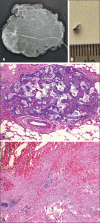Vacuum-assisted excision of breast lesions in surgical de-escalation: where are we?
- PMID: 37564079
- PMCID: PMC10411769
- DOI: 10.1590/0100-3984.2022.0078-en
Vacuum-assisted excision of breast lesions in surgical de-escalation: where are we?
Abstract
Vacuum-assisted excision of breast lesions has come to be widely used in clinical practice. Increased acceptance and availability of the procedure, together with the use of larger needles, has allowed the removal of a greater amount of sample, substantially reducing the surgical upgrade rate and thus increasing the reliability of the results of the procedure. These characteristics result in the potential for surgical de-escalation in selected cases and gain strength in a scenario in which the aim is to reduce costs, as well as the rates of underestimation and overtreatment, without compromising the quality of patient care. The objective of this article is to review the technical parameters and current clinical indications for performing vacuum-assisted excision of breast lesions.
A excisão assistida a vácuo de lesões mamárias tem sido cada vez mais utilizada na prática clínica. A sua maior aceitação e disponibilidade, em associação ao uso de agulhas mais calibrosas, permitiu a retirada de quantidade maior de amostra, reduzindo substancialmente a taxa de subestimação diagnóstica e aumentando, assim, a confiabilidade final dos resultados do procedimento. Essas características resultam em potencial descalonamento cirúrgico, em casos selecionados, e ganham força em um cenário em que se visa a redução de custos, taxa de subestimação e tratamento excessivo, porém, sem comprometer a qualidade no cuidado com o paciente. O objetivo deste trabalho é revisar os parâmetros técnicos e as indicações clínicas atuais para realização de excisão assistida a vácuo em lesões mamárias.
Keywords: Biopsy; Breast neoplasms; Image-guided biopsy; Minimally invasive surgical procedures; needle.
Figures




References
-
- den Dekker BM, van Diest PJ, de Waard SN, et al. Stereotactic 9-gauge vacuum-assisted breast biopsy, how many specimens are needed? Eur J Radiol. 2019;120:108665. - PubMed
-
- Pinder SE, Shaaban A, Deb R, et al. NHS Breast Screening multidisciplinary working group guidelines for the diagnosis and management of breast lesions of uncertain malignant potential on core biopsy (B3 lesions) Clin Radiol. 2018;73:682–692. - PubMed
-
- Park HL, Kwak JY, Jung H, et al. Is mammotome excision feasible for benign breast mass bigger than 3 cm in greatest dimension? J Korean Surg Soc. 2006;70:25–29.
-
- Forester ND, Lowes S, Mitchell E, et al. High risk (B3) breast lesions: what is the incidence of malignancy for individual lesion subtypes? A systematic review and meta-analysis. Eur J Surg Oncol. 2019;45:519–527. - PubMed
-
- Heil J, Sinn P, Richter H, et al. RESPONDER - diagnosis of pathological complete response by vacuum-assisted biopsy after neoadjuvant chemotherapy in breast cancer - a multicenter, confirmative, one-armed, intra-individually-controlled, open, diagnostic trial. BMC Cancer. 2018;18:851. - PMC - PubMed
Publication types
LinkOut - more resources
Full Text Sources
